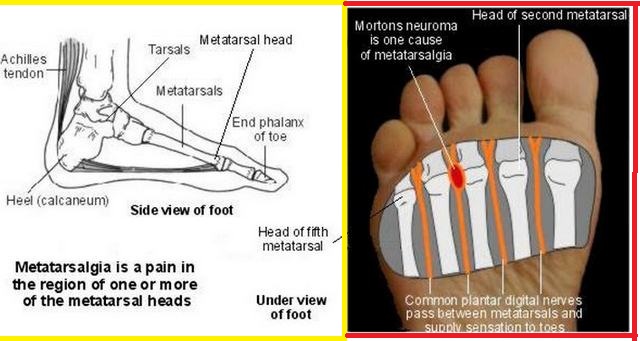Metatarsalgia – Treatment, Symptoms, Exercises, Shoes, Causes
What is Metatarsalgia?
Metatarsalgia (also known as stone bruise, painful foot or ball-of-foot pain) is a medical term used for the inflammation and pain affecting the metatarsal part of the foot. It includes the joints and bones as well as the nerves therein.
Metatarsalgia Symptoms, Signs
Metatarsalgia may be acute, recurrent or chronic. It is also referred to as a symptom and it may conclude another disease therefore, careful examination of the foot must be done. A person may suspect having metatarsalgia when there is:
- Pain felt on the toes (metatarsal area) described as burning, sharp, aching, increasing, localized or extremewhen standing, walking or moving around, alleviated when on bare foot on hard surface and lessened when immobilized.
- Tingling sensation and/or numbness in the toes.
- Swelling.
- May have visible skin lesions and callous formation in the toes especially underneath the second, third and fourth toe.

Image source – Patient.co.uk
Metatarsalgia Causes, Risk Factors
- Stress due to intense exercise such as running wherein the weight of one’s body is transferred to the toes
- Foot injury/fracture
- Faulty distribution of weight on the toes
- Bunion or toe-joint arthritis and gout
- Poor blood supply to the feet due to poor fitting or high-heeled shoes, as well as having diabetes or edema
- Being overweight. Upon standing, the feet become the shock absorber and carry the weight of the body.
- Foot structure or deformities/ flat feet
- Overuse of the toes as to those of the runners and athletes who always undergo strenuous physical activity
- Older people havethinner foot pads therefore have greater pressure on their toes and may cause metatarsalgia
- Morton’s neuroma (Morton’s metatarsalgia) is a benign growth of fibrous tissue that leads to the thickening of the nerves of the toes and contributes to metatarsal stress. This nerve damage has no certain cause, and is common to women who wear high-heeled and constricting shoes. In Morton’s neuroma, sharp, shooting, intermittent pain can be felt when the person wears shoes and relieved immediately when shoes are removed and the foot is manipulated. Localized tenderness over the site of the neuroma can be assessed.
Diagnostic Tests
- Foot X-ray
- MRI
- Ultrasound
- Electromyography
Treatment
A. Simple measures
Sample measures to lessen pain at the front of the foot
- Remove shoes and massage the painful toes gently several times a day.
- Rest and elevate your feet.
- Apply ice packs wrapped in thin sheet of cloth to the painful area for 20 minutes as needed
- Compress by putting pressure bandage on the area.
- Wear nice fitting shoes and socks. Avoid walking barefooted.
- Keep a normal weight.
B. Medications for metatarsalgia
- Non-steroidal Anti-inflammatory Drugs (i.e. Ibuprofen, Diclofenac Sodium)
- Astringents
- Emollients
- Ointments
- Corticosteroid injection
- Anaesthetics
- Sclerosant injections
C. Orthotics or footpads
Footpads duly fitted and prescribed by a podiatrist or physician
- Rigid
- Semi-rigid
D. Shock absorbing insoles
Shock absorbing insoles to cushion the toes
- Cork
- Rubber
- Plastic
- Gel-like substance
E. Exercises for Matatarsalgia
- Calf muscle stretch, done as if you are pushing the wall. Put your hands on the wall, one foot in front of the other, and the back heel on the floor and knee straight. Do this for 30-60 seconds, twice a day.
- Ankle extension and flexion is done while sitting in a chair, with your painful foot over your other knee. For the ankle extension, hold the ankle and pull the toes of your painful foot towards you. For the ankle flexion, hold the ankle and pull the toes towards your lower leg. Do this for 10 seconds, in 3 sets of 8 repetitions per day, 10 seconds of rest on between.
- Achilles Tendon Stretch is done while sitting on a chair, with your legs straight infront of you. Grasp your toes and pull it towards your knees. Hold this for 10 seconds and relax. Do 3 sets of 10 per day.
- Plantar flexion and dorsiflexion is done with your legs extended while sitting in a chair. Curl your toes as tightly as you can, relax, then, point the toes towards your knee. Hold for 10 seconds and relax. Repeat 10 times.
F. Metatarsalgia shoes
Metatarsalgia shoes must have:
- Soft and comfortable soles;
- Cushioned and well-fitted arch;
- Enough space for the forefoot to relax;
- Ability to help feet absorb shock;
- Proper materials for individual needs
Surgery
Surgery is not so often necessary but it could be done to realign, reshape or modify metatarsal bones. In Morton’s neuroma, there are two surgical options. One is tocut the metatarsal ligament to give space for the nerve known as nerve decompression, and the other is to remove the nerve on the affected area known as nerve resection.
A small incision will be made either on the top or on the sole of the foot, in between the painful toes.
The operation is mostly done in an out-patient basis, depending on the severity of the condition. The patient may or may not be put in cast, and may or may not be allowed to walk. It may take up to 3 months or more to recover, but, might still have limitations on foot activities.
So with the other surgeries, there are risks involve which includes infection, delayed healing of the surgical incision, broken pins, delayed bone-healing and nerve injury that can cause damage in the circulation and altered sensation of the toes.